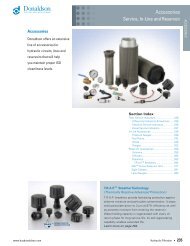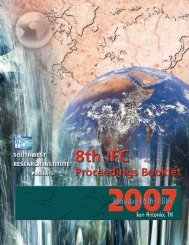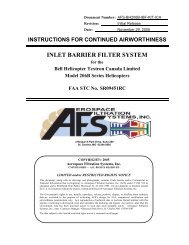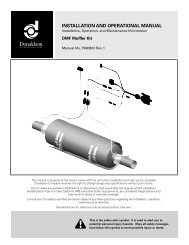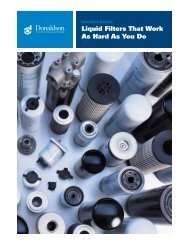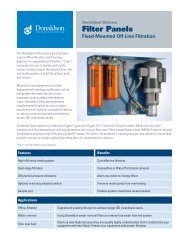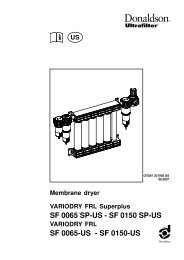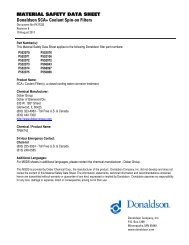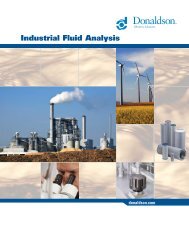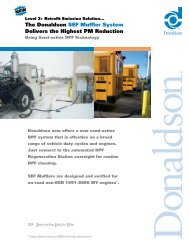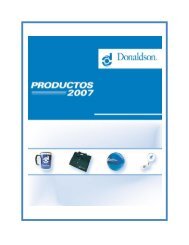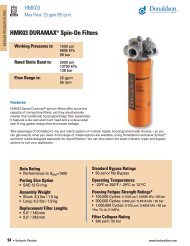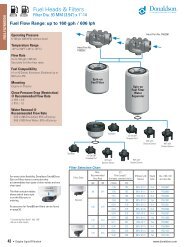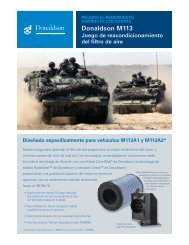Hydraulic Filtration Technical Reference - Donaldson Company, Inc.
Hydraulic Filtration Technical Reference - Donaldson Company, Inc.
Hydraulic Filtration Technical Reference - Donaldson Company, Inc.
You also want an ePaper? Increase the reach of your titles
YUMPU automatically turns print PDFs into web optimized ePapers that Google loves.
Proper Filter Application<br />
When selecting a new filter assembly or replacement<br />
filter, it’s important to first answer some basic<br />
questions about your application. Where will the<br />
filter be used? What is the required cleanliness level<br />
(ISO code) of your system? What type of oil are you<br />
filtering? Are there specific problems that needed to<br />
be addressed?<br />
It’s also important to think about the viscosity<br />
of the fluid in your system. In some machinery<br />
lubrication applications, for example, the oil is very<br />
thick and has a tougher time passing through the layer<br />
of media fibers. Heating techniques and the addition<br />
of polymers can make the liquid less viscous and<br />
therefore easier to filter. Another option is to install<br />
a filter with larger media surface area, such as the<br />
<strong>Donaldson</strong> W041 or HRK10 low pressure filters, that<br />
can accommodate more viscous fluids.<br />
Next, think about duty cycle and flow issues. Working<br />
components such as cylinders often create wide<br />
variations in flow—also called pulsating flow —that can<br />
be problematic for filters with higher efficiency ratings.<br />
On the other hand, dedicated off-line filtration (also<br />
called “kidney loop”) produces a very consistent flow,<br />
so it makes sense to use a more efficient filter. Learn<br />
more about off-line filtration on page 352.<br />
Filters used in applications with steady, continuous<br />
operation at lower pressures will last longer than filters<br />
that must endure cycles of high pressure pulsating<br />
flow. Generally, the lower the micron rating of a filter,<br />
the more often it needs to be changed since it is<br />
trapping more particles.<br />
Finally, it’s wise to ask yourself, “How much is my<br />
equipment worth?” Calculate how much it would cost<br />
to replace the equipment in your system, in case of<br />
component failure, and make sure those areas are well<br />
protected with proper filtration. (For example, high<br />
performance servo valves are very sensitive, costly<br />
components that need to be protected with finer<br />
filtration media.)<br />
Minimizing maintenance costs through good<br />
contamination control practices requires proper filter<br />
application based on the specific contamination<br />
problems. Good contamination control means costeffective<br />
filtration. When looking for a filter, first assess<br />
the needs of your system and any problem areas.<br />
Learn more about proper filter positioning on page 352.<br />
www.buydonaldson.com<br />
Fluid Properties<br />
<strong>Technical</strong> <strong>Reference</strong><br />
Characteristics to Consider<br />
When Specifying a <strong>Filtration</strong> System<br />
1) Oil Viscosity<br />
2) Flow<br />
3) Pressure<br />
4) What Components will be protected by the filter<br />
5) Cleanliness level required (expressed in<br />
ISO code)<br />
6) Type of oil/fluid<br />
7) Environment (the system, the surrounding<br />
conditions, etc.)<br />
8) Duty cycle<br />
9) Operating Temperature<br />
A <strong>Hydraulic</strong> System Design Worksheet is available on page 335.<br />
Lubricity The property of the fluid that keeps friction<br />
low and maintains an adequate film between moving<br />
parts.<br />
Viscosity The thickness of the fluid as measured by<br />
resistance to flow. The fluid must be thin enough to<br />
flow freely, heavy enough to prevent wear and leakage.<br />
<strong>Hydraulic</strong> fluids thicken when they cool and thin out as<br />
they heat up. Because some hydraulic systems work<br />
under wide temperature extremes, viscosity can be an<br />
important factor.<br />
Viscosity Index (VI) The rate of viscosity change<br />
with temperature: the higher the index, the more stable<br />
the viscosity as temperature varies. VI can sometimes<br />
be improved by additives, usually polymers.<br />
Rust Resistance Rust inhibiting chemicals in<br />
hydraulic fluids help overcome the effects of moisture<br />
from condensation.<br />
Oxidation Resistance Oxidation inhibitors delay the<br />
sludgy/acidic effects of air, heat, and contamination in<br />
the system.<br />
Foaming Resistance Although control of foaming<br />
depends largely on reservoir design, anti-foaming<br />
additives in the fluid also help.<br />
<strong>Hydraulic</strong> <strong>Filtration</strong> • 333<br />
HYDRAULIC FILTRATION - TECHNICAL REFERENCE



